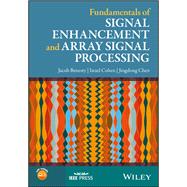A comprehensive guide to the theory and practice of signal enhancement and array signal processing, including matlab codes, exercises and instructor and solution manuals
- Systematically introduces the fundamental principles, theory and applications of signal enhancement and array signal processing in an accessible manner
- Offers an updated and relevant treatment of array signal processing with rigor and concision
- Features a companion website that includes presentation files with lecture notes, homework exercises, course projects, solution manuals, instructor manuals, and Matlab codes for the examples in the book









